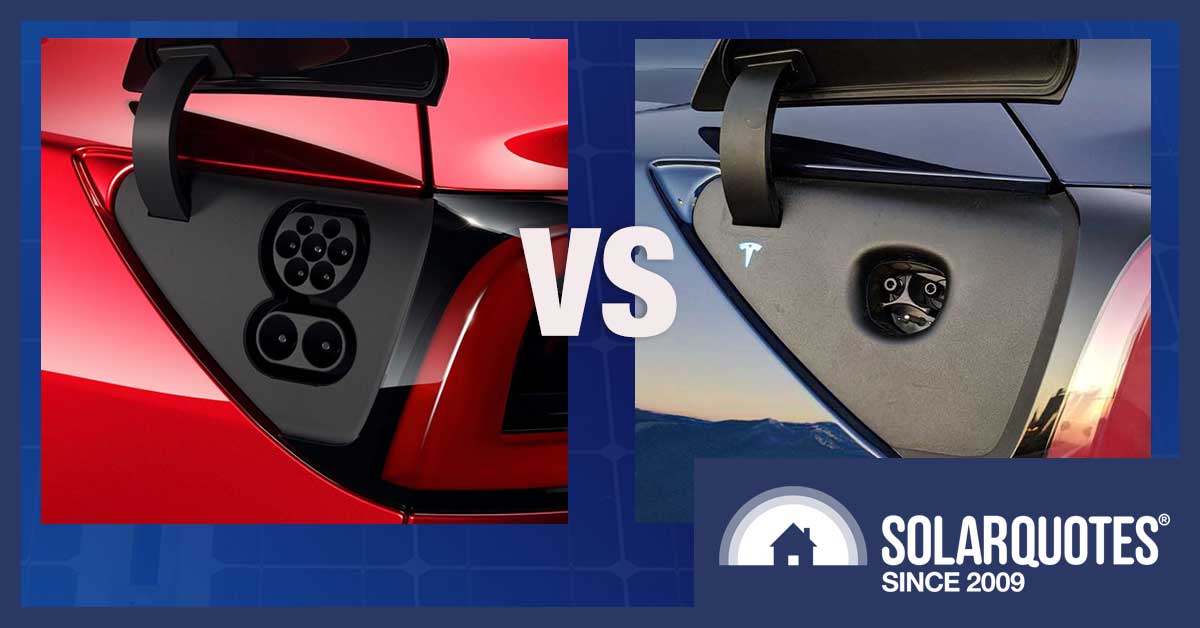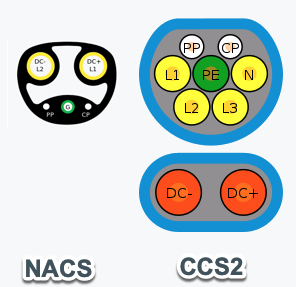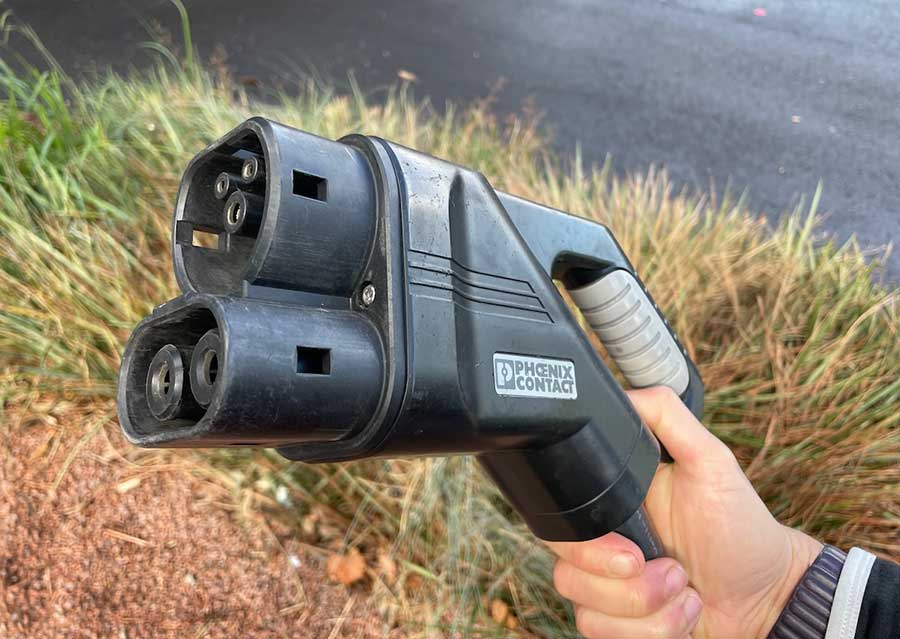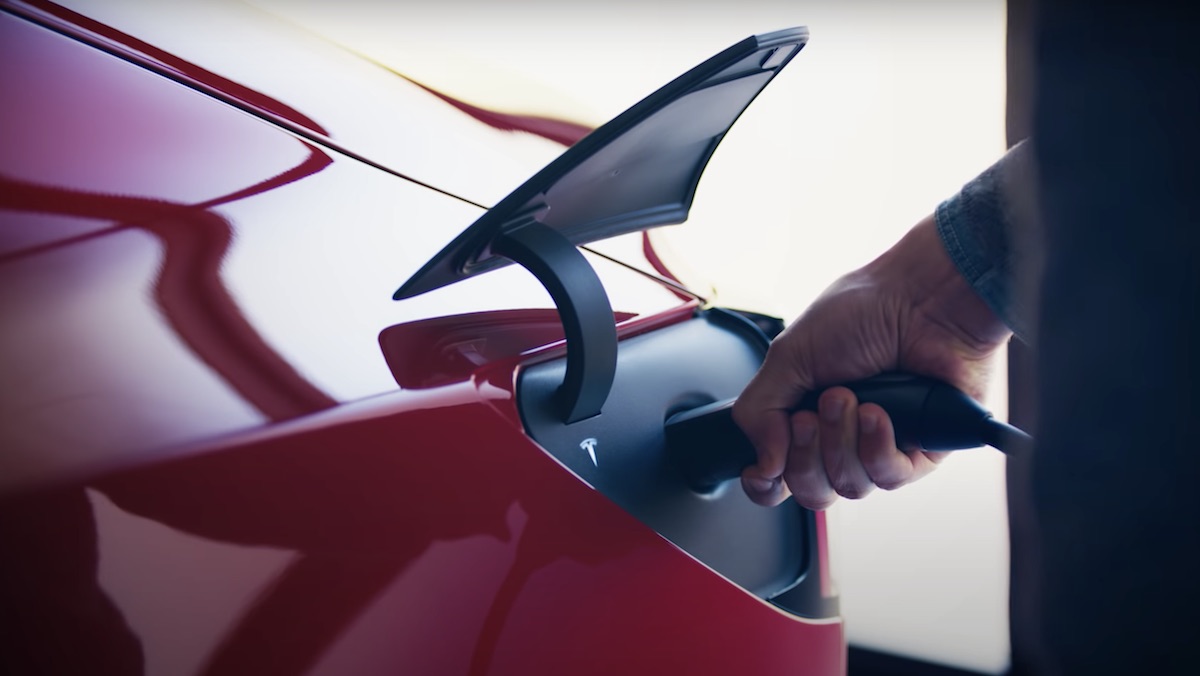
The Australian-adopted CCS2 charge port and Tesla’s NACS port.
In a welcome development for American EV owners, SAE International (formerly the Society for Automotive Engineers) has announced it will standardise Tesla’s North American Charging Standard (NACS) connector. But don’t expect Australia to follow suit.
SAE’s media release says:
“This will ensure that any supplier or manufacturer will be able to use, manufacture, or deploy the NACS connector on electric vehicles (EVs) and at charging stations across North America”
Many US automakers, including Tesla, Ford, General Motors and Rivian, and charger-makers are now adopting NACS vindicating Tesla’s decade-long, go-it-alone approach to EV charging connector design.
Why Australia Is Unlikely To Adopt NACS
It will be hard for Australia to move to Tesla’s connector for one reason: NACS cannot support 3-phase AC charging. NACS only has two pins for power delivery, whereas 3-phase charging requires four pins (3 lives and one neutral).
In Australia, we have adopted a standard called Type2/CCS2, which limits single-phase AC chargers to just over 7 kW. To charge your car faster with an AC charger in Australia, you need 3 phases allowing up to 22kW of charging speed.
In theory, NACS can deliver 22 kW on one phase, because it is rated to 277V AC and 80A. Power is voltage x current, and 277 x 80 = 22.16 kW. But to get the full 22kW would require stepping up the 230V delivered by the grid, and pulling 80A from a single phase, which is either over the limit of many residential supplies, or pushing the main breaker’s capacity.
There are technical solutions to this. The home charger (EVSE) could combine 3 phases of 26.6A into a single phase before delivering it through a NACS connector. The EVSE could also increase the voltage internally.
Why Tesla Designed Their Own Connector
The NACs connector is an elegant design. It uses the same two pins for charging with AC and DC, compared with the clunky Type2/CCS2 arrangement, which has separate pins:

The Tesla NACS connector on the left, and the CCS2 connector we’ve adopted in Australia on the right
Anyone who has charged an EV in Australia will remember feeling shocked at the size of the CCS2 plug the first time they had to DC charge. It’s enormous and requires way more raw materials than NACS:

You need this huge plug for DC charging a recent EV in Australia.

The NACS connector can DC charge in a much smaller package. Image: Tesla
The adoption of Tesla’s NACS connector by SAE International is a big win for American EV drivers, making charging hardware cheaper, and the charging experience simpler. But don’t expect to see it in Australia anytime soon. Our electrical infrastructure favours the Type2/CCS2 connector, and changing that over to NACS would be a right royal pain in the charging port.
If you want to understand EV charging in Australia, please be aware that we do things a little differently to the rest of the world. Happily, my EV Charging 101 guide gives you everything you need to know for low-stress charging at home and on the road.

 RSS - Posts
RSS - Posts



It is stupid for an EV to carry an onboard charger. Waste of weight and design space. All charging should be DC bi-directional and the NACS is well-suited. The CCS2 is a typical compromise created by bureaucrats instead of engineers.
Far out, never realised the connector was that enormousous. Looks awkward.
I can now see why NACS is winning in the US. Does it also do bi directional so it’ll charge your home too? If so, we’re Muppets if we don’t follow suit.
My laptop and phone have the transformer on the outside, don’t see why cars need to be any different.
No, NACS is not bidirectional. Rumours abound, but Elon Musk has occasionally said he thinks that V2 anything is a bad idea, and Tesla’s owner’s manual says it will void your warranty.
But I think Ford and GM are advertising V2H systems compatible with their pickup trucks.
CHAdeMO is bidirectional, but the matching bidirectional chargers are $4,000 up, and mostly nonexistent. And the connector is even bigger / clumsier to handle, than CCS.
NACS connector and in car electronics is technically capable of DC bidirectional power as it just has a high power relay that closes to give a direct connection to the EV main battery for DC charging . – this is how most high power DC charging systems work – NACS, Chademo and CCS.
The relay is required to provide isolation even on CSS where it has dedicated DC pins as you can’t just have exposed 400 Volt terminals anywhere someone could touch them.
It’s just a matter of whether manufacturer’s want to support bidirectional and risk degrading the battery life of the very expensive EV battery pack.
Anyone with a NACS or CCS vehicle could probably install a modification kit to command the isolator relay to close even if the car manufacturer did not offer it and thereby get bidirectional power access.
In the case of Tesla their cars could probably support bidirectional power with a software update if they wanted.
Of course V2G etc still requires a bunch of other stuff outside the car like inverters and a control system to work out when to charge or discharge etc to be of any use.
Absolutely spot on. And as this article writer says it can be resolved in the unit on the wall. And no the car manufacturers are not going to ship a special plug for a few hundred thousand australians
100% correct.
All superchargers are supplying DC (AFAIK) and I expect it would make more financial sense to move the 3 phase AC to DC electronics out of every new vehicle and into the home wall charger (if and when it is required).
Now give me my NACS plug! 🙂
I believe the internal charger comes almost free, using the same rectifier as regen braking, not 100% sure but it would make a lot of sense.
This is one of many reasons I haven’t even thought buying a EV. I want to buy an EV that comes wit a cable that I can use anywhere , anytime , that is completely universal .One cable that I can stop Any charging point in Australia . I’m sure this puts many other potential buyers off as well
If that’s all that’s stopping you you can have my referral code…I can charge Model 3 at every public charging station and every power point.
I don’t understand your issue. Go to a fast charger plug in and charge. At home, do the same from your wall charger. Can’t be any easier. Why is that stopping you buying an EV?
For CCS why isn’t there a separate smaller plug for DC charging that only plugs in to the bottom pins?
Because the comms that controls it are above in the mennekes connection
Only comment I can make re NACS: 277v is abt 240+10%, so the current draw from a Single phase would be abt 10% higher, or approx 88A rms
I just wish we could use economical home-based DC chargers (NACS or otherwise). Surely there would not be much more technology in a bi-directional DC charger compared to a PV inverter? If the design was mass marketed, surely it could approach a normal Inverter price?
Once we had bi-directional DC charging, it would be much easier to use the vehicle as a home battery. Also, then as Martin suggested, we would not need to lug around an AC in-built charger.
I just checked and my house doesn’t supply DC power.
I do have 3 phase AC though and 240V AC.
Im not sure switching the country from AC power to DC power is a realistic plan so we probably need conversion on board our cars.
Otherwise we will need to spend a lot of money every single place we want to recharge a car putting special equipment in.
Last I checked DC fast charging isn’t viable at the home level.
No one is suggesting we switch to DC power. To DC charge, you buy an (expensive) box that takes AC in and puts DC out.
Is the size of the CCS2 connector really that big of an issue?
I have had no issue using one. Nor have I seen fellow motorists struggling to plug one in at fast chargers.
Why go small for the sake of small if larger and robust does the job?
Yes, I have seen people struggling on 350kW chargers. Specially elderly or women.
Every DC connector is bidirectional. Its just a protocol thing.
You realize that you have an AC to DC converter already. But instead of being inside the car wasting space and energy it could be part of your wall charger at home. I own a spare Tesla 11kW charger and it’s a heavy and big beast. 2 of them are mounted in my car (22kW AC charging) which has been handy when travelling inland Australia. But now there are DC fast charger in every town (soonish) and the AC on-board charger kinda become obsolete.
I’m charging onw of our EVs from an AC outlet right now. Soon I’m going to move it and plug in the other one.
I had to buy an EVSE adapter for the Tesla separately, $350. To put the entire AC to DC converter on that cable might cost a hefty chunk of cash, and I’d have to carry it with me to charge from AC wall plugs.
Btw, older laptops all had the AC to DC supply, built in. And they were well built and reliable.
But the day when I’ll drive the EV 10 km away and watchbit charge, at 50% more cost, is never coming.
“If you want to understand EV charging in Australia, please be aware that we do things a little differently to the rest of the world. ”
Especially the last sentence and don’t Defence Manufacturers love it. $-)
EV charging outside the Tesla SuC network is indeed a little bit different: A total disaster of single highly unreliable locally made DC fast chargers. Takes months to repair too, great stuff. Has absolutely nothing to do with the physical connector or its protocol.
My understanding is that only North America is currently adopting NACS so we will not be the only country that is left out for now. However, having experienced EV road tripping with NACS in North America it would be good to have it one day, perhaps when other parts of the world starts to implement this change.
22kW is nowhere near enough. It would take almost 3 hours to fully charge my BYD, whereas the current fast chargers do it in under an hour. That makes travel in our very spread out country possible where you usually drive around 1000km in a day while on the road. I’m not going to be able to have a 3 hour lunch break and still get where I need to go. IMO the Australian option for fast DC charging is much better.
About 22 KW is only the single-phase AC limit for home / destination chargers using the NACS connector.
The 3 year old DC Tesla Supercharger max output of the chargets in our small Canadian farming town, is 250 KW. It’s soon to br 324 MW.
The NACS connector is not much more likely to come to Australia, than are fuel pumps selling in 3.78 litre U.S. Gallons in exc hange for U.S. Dollars.
https://www.tesla.com/en_au/charging
Read about Tesla Superchargers. They use the same connector with up to 250kW charging (275 km in a 15 min charging stop after driving 400 km and more). So you need to stop 15 min to drive 675 km. Is that fast enough?
CCS DC fast charging in Australia is even faster – up to 350kW – than the Tesla Superchargers. But most of the DC fast chargers in Australia are 50kW/75kW/150kW at the moment.
You can see all chargers in Australia on https://www.plugshare.com/
https://ev-database.org/
They list all EVs, their range (WLTP standard) and charging speed/times.
Tesla V4 superchargers will apparently support up to 615kW (615A @ 1000V).
The NACS standard supports both 500V and 1000V charging with no maximum defined current (implementation dependant), with successful operation above 900A with a non-liquid cooled vehicle inlet (Ref: https://tesla-cdn.thron.com/static/HXVNIC_North_American_Charging_Standard_Technical_Specification_TS-0023666_HFTPKZ.pdf?xseo=&response-content-disposition=inline%3Bfilename%3D%22North-American-Charging-Standard-Technical-Specification-TS-0023666.pdf%22 )
Given the choice, I’d take the NACS plug over the CCS2 monster any day.
Sorry, I might be a little slow, but can anyone tell me what is fundamentally different about the US and Australian grids – and why this problem is unique to Australia?
Wouldn’t the lack of pins on the NACS standard also cause this problem in the US home charging installations (and all over the world as well)?
The power grids are pretty much the same until you get closer to the outlet.
The difference is that many Australian homes have a 3-phase connection from the grid, but North American homes are connected to only one phase of the three.
Single phase requires only 1 distribution grid wire (with an earth return) and 1 step-down transformer, while 3 phase needs 3. I don’t know the whole history, but my understanding is that it was a cheaper and simpler way to have electric light and a few small appliamces in every home and farm, and safer than kerosene lamps
The big difference is that in Australia, we often install 3-phase power into our houses. From a grid management perspective, balanced 3-phase loads are better for generators and transformers.
The usa has a 240v split phase system with houses getting two phases of 120v for even high loads. 3-phase is almost unheard of in residential installs.
It would be possible to design a NACS-style connector with shared pins, and a smaller PE layout, but that would make us inherently incomparable with Europe and China, which also use 230v 3-phase residential installs.
One thing people don’t seem to understand is that below about 50kW, the motor driver can be used
Further dc fast chargers generally need 1500V supply or higher in order to be efficient, which is generally not installed into a consumer environment.